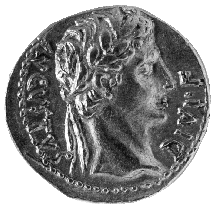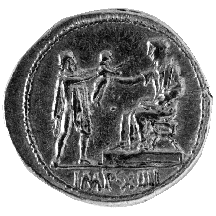



(68) Augustus - AV aureus, 9-8 B.C., 7.76 g. (inv. 91.110).
Obverse: Laureate head of Augustus r.; AVGVSTVS DIVI F(ILIVS): Augustus,
son of a god (the Divine Julius Caesar).
Reverse: Augustus, togate, seated l. on stool on platform, extending r.
to infant held toward him by figure wearing cloak; in exergue, IMP(ERATOR)
XIIII: imperator for the fourteenth time.
Provenance: Abner Kreisberg, 1970.
Bibliography: C.H.V. Sutherland, The Roman Imperial Coinage I: from 31
BC to AD 69, rev. ed. (London 1984) 201a.
A major goal of Augustan policy in the West was to move the western frontier
of the empire from the Alps, close enough to allow incursions into Italy
from the tribes to the north, to the Rhine and eventually to the Elbe rivers.
Augustus worked out the strategy for the campaign while he was in Lugdunum
(modern Lyons) from 16 to 13 B.C.
From 12 to 9 B.C. there were successes under his stepsons, Drusus and Tiberius,
which were celebrated on the reverse of this coin issued in Lugdunum depicting
a defeated German presenting a child to the seated emperor. These victories
were soon followed by revolts, however, and the Roman forces were eventually
forced back to the Rhine.
C.L.L.



All contents copyright (c) 1996.
Lawrence University
All rights reserved.